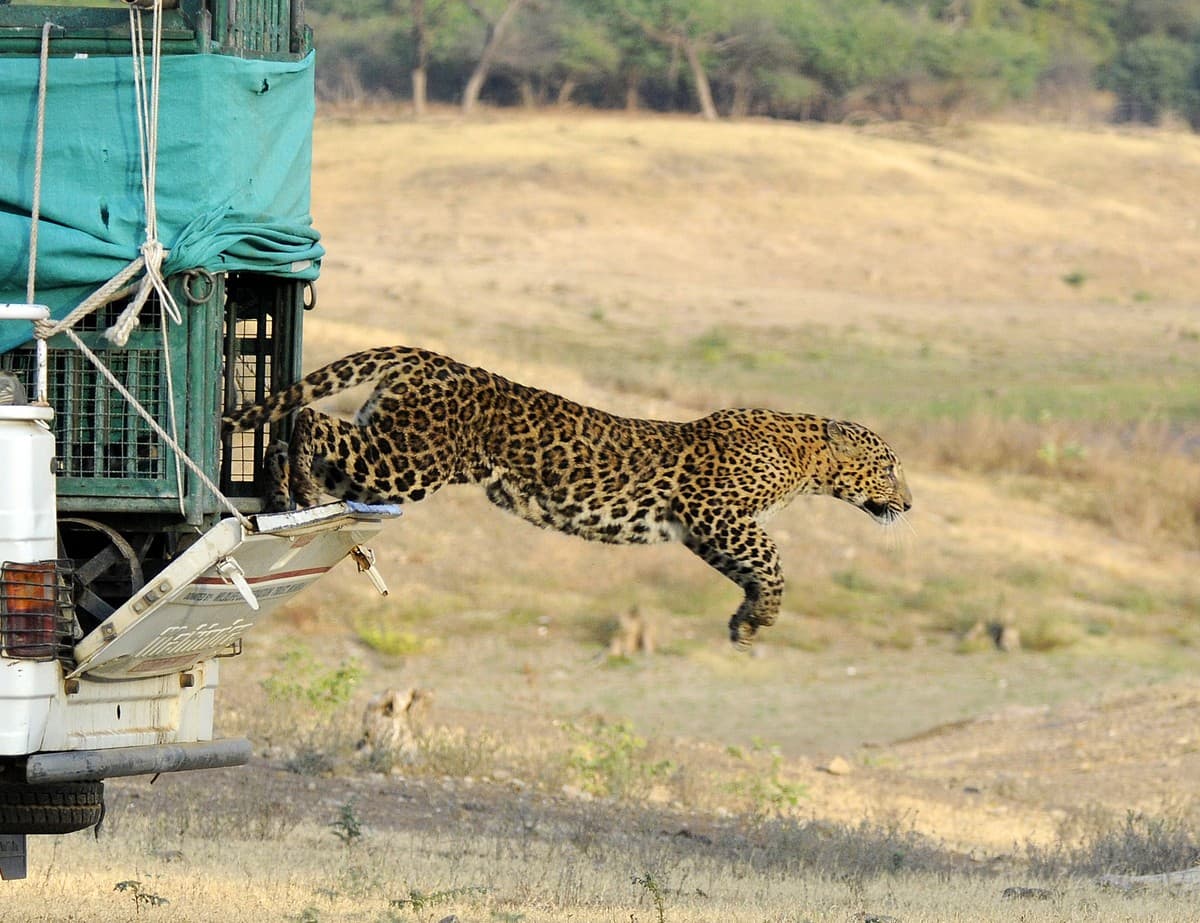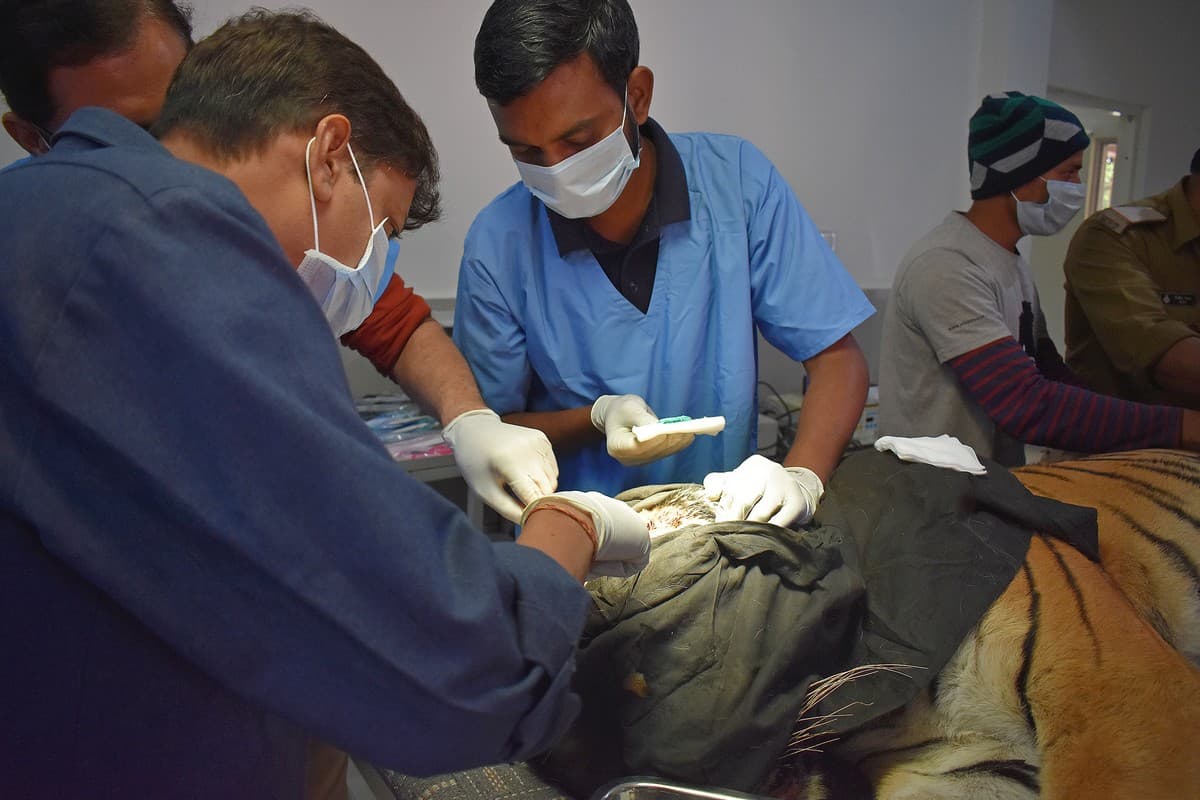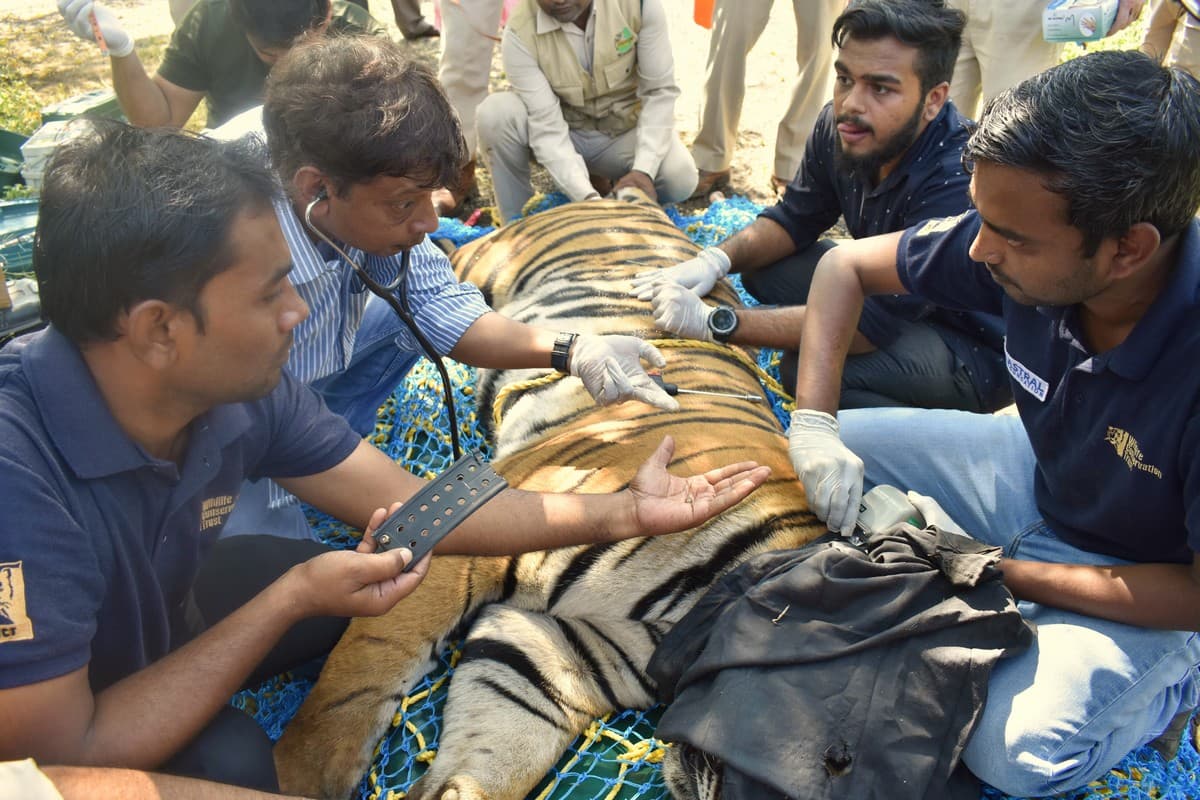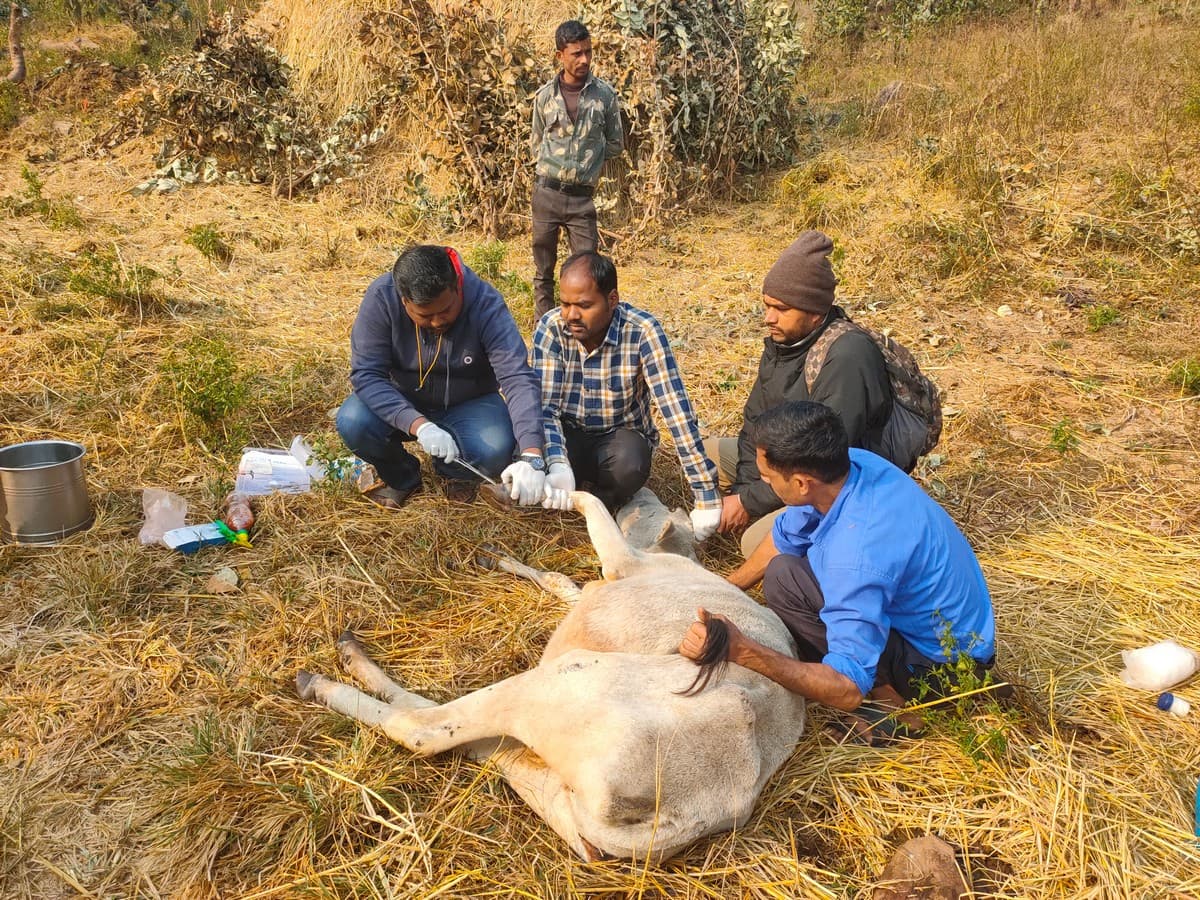“Veterinarians are irrevocable generalists,” reads a line in the book Veterinary Anatomy and Physiology. While most people associate a veterinarian only with treatment and welfare of individual animals, their role extends to maintaining the health of wildlife populations and ecosystems at large. Be it wildlife research, rescue, rehabilitation, translocation, monitoring of infectious diseases, mortality investigation of animals, and more, a veterinarian is at the centre, orchestrating challenging and multi-sectoral interventions. Today, wildlife veterinarians are key to tackling a plethora of emerging and complex conservation challenges of our time, such as human-wildlife conflict and emerging diseases, yet they often lack training with respect to dealing with wildlife species and their diseases.

Despite their irrefutable need in almost every in-situ and ex-situ wildlife conservation project, the veterinary ecosystem in India is far from robust, according to a report by Mongabay India, which states: “There is no shortage of veterinarians in the country as far as zoos are concerned as no zoo can get recognition from the CZA (Central Zoo Authority) until they have a veterinary officer. However, the real issue is the capacity building of the veterinarians in the country with respect to dealing with several wildlife species and all types of diseases in them.”
In the wake of COVID-19, the link between animal, human, and ecosystem health has been acknowledged widely. Despite this, the understated yet formidable threat of transmission of diseases, especially at the interface of livestock/feral/free-ranging animals and wild animals has not been made a conservation priority by wildlife managers, animal husbandry agencies, and policymakers in India.
Purva Variyar spoke to Dr. Prashant Deshmukh and Dr. Himanshu Joshi, experienced wildlife veterinarians with the Wildlife Conservation Trust (WCT), to understand the grand scope of impact that veterinarians’ work has on wildlife conservation efforts. Dr. Deshmukh heads WCT’s Human-Wildlife Interface Management division, and Dr. Joshi helms the Wildlife-Livestock Disease Interface Management programme in Madhya Pradesh. They work closely with the Madhya Pradesh Forest Department and Animal Husbandry Department and play key roles in managing human-carnivore conflict and the spread of dangerous infectious diseases within livestock and wildlife populations in the state.
What kind of acumen, knowledge, and skills do veterinarians bring to the wildlife conservation table?
PRASHANT: Veterinarians contribute to wildlife conservation using a wide range of expertise and skills. Since wildlife health management is a core skill for veterinarians, they can take the lead in capturing and handling of wildlife in distress, wildlife rehabilitation, field research, interdisciplinary collaborations for implementation of One Health policies, policy development, disease surveillance and control, and wildlife crime investigation through application of veterinary forensics, among other things. Veterinarians thus bring a mix of veterinary, ecological, and conservation skills that are useful for wildlife protection.
In cases of human-carnivore conflict, rescue and translocation of wild animals such as a tiger or leopard, can be extremely complex and challenging. Prashant, as a veterinarian assisting the Forest Department, which tasks do you have to take on during these operations?
PRASHANT: In cases of human carnivore conflict, the situation often involves instances where wild animals such as tigers or leopards enter human settlements, leading to attacks on livestock, or even people. My role involves a combination of veterinary skills and expertise, logistical planning, and collaboration with various stakeholders (Forest Departments and law enforcement agencies) to ensure the safe and ethical handling of wildlife in conflict situations.
We are also involved in rehabilitation and post-release monitoring of the carnivore. Our team deploys satellite collars on translocated tigers and leopards. This initiative aims to monitor the wellbeing of these animals at the release site, utilising advanced satellite technology for ongoing tracking and observation. Our involvement as veterinarians enhances the overall effectiveness of management and understanding of human-carnivore interactions, contributing to conservation efforts in the region.

You have worked with species as rare and elusive as pangolins and Eurasian otters as part of WCT’s research and rehabilitation projects. You also assist the forest staff in rescue, rehabilitation, and treatment of varied wildlife. How does your approach vary with every species?
PRASHANT: While there are specific considerations for each species, the overarching approach remains rooted in the wellbeing and ethical treatment of animals. The fundamental principles include minimising stress, providing appropriate veterinary care, and creating environments that promote natural behaviours. Regardless of the species, the focus is on ethical practices to enhance the health and chances of successful rehabilitation for each individual animal.
Himanshu, can you explain the significant threat of disease transmission from livestock to wildlife and vice-versa on our wildlife, livelihoods, and economy?
HIMANSHU: In and around forests, communities with an agrarian lifestyle raise livestock, creating competition with wild herbivores for shared resources such as land, grazing areas, and water. Diseases pose a dual threat to both livestock and wild herbivores, with unchecked outbreaks leading to devastating epidemics. This has profound repercussions, impacting the prey base for predators and hindering conservation efforts, while also affecting the economy of communities dependent on livestock.
Pathogens, including bacteria, viruses, fungi, and parasites, persist in the environment and within both domestic and wild animals. Transmission occurs through excretions or carcasses, affecting healthy animals directly or through environmental contact. Interface zones, or areas where there is increased interaction between livestock and wild animals, are especially common near Protected Areas such as national parks and tiger reserves. Such areas are hotspots for diseases such as Foot-and-Mouth Disease (FMD), rabies, bovine tuberculosis, canine distemper, and Lumpy Skin Disease (LSD). The consequences are severe, causing morbidity and mortality in wildlife, endangering species, and threatening other animals in the vicinity. In domestic animals, diseases result in reduced milk production, debility, infertility, and death, translating into epidemics affecting entire communities and even hindering exports of agricultural products. This poses a multifaceted threat to the environment, livelihoods, and the economy at various scales. The impact extends beyond individual farmers to the nation’s ability to participate in the global market owing to disease outbreaks affecting agricultural exports.
Additionally, zoonotic diseases (diseases transmissible from animals to humans) such as tuberculosis and Kyasanur Forest Disease (KFD) pose a significant threat to people.

How does your expertise as a veterinarian come into play here? How is WCT’s Wildlife-Livestock Disease Interface Management programme working to address this issue?
HIMANSHU: In my role as a veterinarian, comprehending the intricacies of diseases such as their etiology (origin or cause of a disease), pathogens involved, and their pathogenesis, including symptoms and progression – forms the foundation for understanding the potential threats they pose to livestock, wildlife, and humans alike. However, a critical gap exists in our knowledge regarding baseline data on disease prevalence, factors contributing to outbreaks, and the persistence of pathogens circulating within ecosystems.
The WCT programme is actively addressing this gap by prioritising the generation of baseline data through multisectoral collaborations with different stakeholders such as the Forest Department, Animal Husbandry Department, and veterinary institutions, and ensuring their participation. This approach serves as a crucial foundation for establishing a robust surveillance system. The aim is to gain insights into the prevalence of diseases, the persistence of pathogens, and the identification of risk factors that contribute to their circulation in populations. The overarching goal is to develop effective strategies for control and prevention, mitigating the risk of outbreaks in both wild populations and livestock.
In cases of human-carnivore conflict, the situation often involves instances where wild animals such as leopards enter settlements, leading to attacks on livestock, or even people. A vet’s role involves a combination of veterinary skills and expertise, logistical planning, and collaboration with various stakeholders to ensure the safe and ethical handling of wildlife in conflict situations.
Is there a shortage of veterinarians with skills required for wildlife interventions in India? What measures can be taken to make India’s veterinary ecosystem more robust?
HIMANSHU: There’s a dearth of skilled professionals and facilities, especially for wildlife interventions and health management. To address this, veterinary education should cover wildlife health more thoroughly at the graduate level. More universities should offer specialised Master’s and Ph.D. programmes for wildlife health. Veterinarians employed in state animal and forest departments, along with non-governmental organisations, need capacity building in approaching wildlife and necessary interventions. We also need systematic solutions, such as encouraging veterinarians towards wildlife conservation by creating opportunities in private and public sectors for effective wildlife management and conservation.
To encourage veterinarians to join the Forest Department and continue to serve for decades, it is important to have a separate cadre with scope for promotion in the same way as observed in the Indian Forest Service (IFS) in the civil services. This will go a long way in matching salaries with competing jobs in the animal husbandry department. Currently, in most states, this is non-existent. As a result, even vets who are passionate about wildlife, despite the hardships and dangers of working with wild animals, are eventually lost to the dairy industry or private practices that involve wellbeing of domestic animals and pets.
Could you briefly tell us about your academic and professional journeys as veterinarians for the benefit of aspiring vets?
HIMANSHU: I am an alumnus of Bombay Veterinary College and hold a Ph.D. in Wildlife Health Management from the School for Wildlife Forensic and Health (SWFH), NDVSU, Jabalpur. During my Masters’ and Ph.D. research, I investigated the causes of mortality in gharial hatchlings, used various molecular tools, and conducted field surveys to study kinship in gharial in the National Chambal Sanctuary. As a veterinarian, I was involved in resolving human-leopard conflict situations in Mumbai. I was briefly associated with the Pench Tiger Reserve, Maharashtra, as a Veterinary Officer, and then as a Research Associate at SWFH, where I assisted in developing techniques for species identification and disease diagnosis using molecular markers. I was part of a team of veterinarians that conducted health examination, disease surveillance, translocation, and treatment of free-ranging wild animals in various Protected Areas across Central India.
At WCT, I am involved in planning and conducting epidemiological studies and prophylaxis (disease prevention) of infectious diseases at the wildlife-livestock interface, especially concerning FMD and tuberculosis in Protected Areas in Central India. I am also involved in assisting the Forest Department in treatment, rescue, and translocation operations involving large carnivores and herbivores, and conducting post-mortems to ascertain causes of wild animal deaths. I am also involved in collaborating with different stakeholders to execute projects and create training programmes for their capacity building.

What about you, Prashant?
PRASHANT: After my Bachelor’s degree in veterinary science and animal husbandry from Kranti Sinha Nana Patil College of Veterinary Sciences, Shirwal, Maharashtra, I pursued a Master’s in wildlife sciences from Emporia State University, Kansas, USA. My professional journey commenced with multiple internships in wildlife departments and rescue and rehabilitation centres, which gave me hands-on experience. Subsequently, I joined non-profit organisations dedicated to animal welfare and wildlife conservation, such as the Wildlife Trust of India. A pivotal aspect of my career has been a commitment to continued learning in the realms of rescue, rehabilitation, and conservation. This ongoing learning has been instrumental in staying abreast with the latest developments and best practices in these critical fields. I have been heading WCT’s HWIM vertical since 2017.
This article was originally published in Sanctuary Asia June 2024 issue.
About the author:
Purva Variyar is a wildlife conservationist, science writer and editor, and heads WCT’s Communications vertical. She has previously worked with the Sanctuary Nature Foundation, and The Gerry Martin Project.
Disclaimer: The author is associated with Wildlife Conservation Trust. The views and opinions expressed in the article are her own and do not necessarily reflect the views and opinions of Wildlife Conservation Trust.
Your donations support our on-ground operations, helping us meet our conservation goals.
Related Links
- Capacity Building Workshop for Veterinarians on Management of Freshwater Animals in Distress was held at Jaipur
- The Impact Of One Health On Conservation
- Supporting Veterinary Doctors and Trackers in Gir
- Averting Epidemics – WCT’s Disease Surveillance Project
- Averting Extinction – One Blood Sample at a Time
